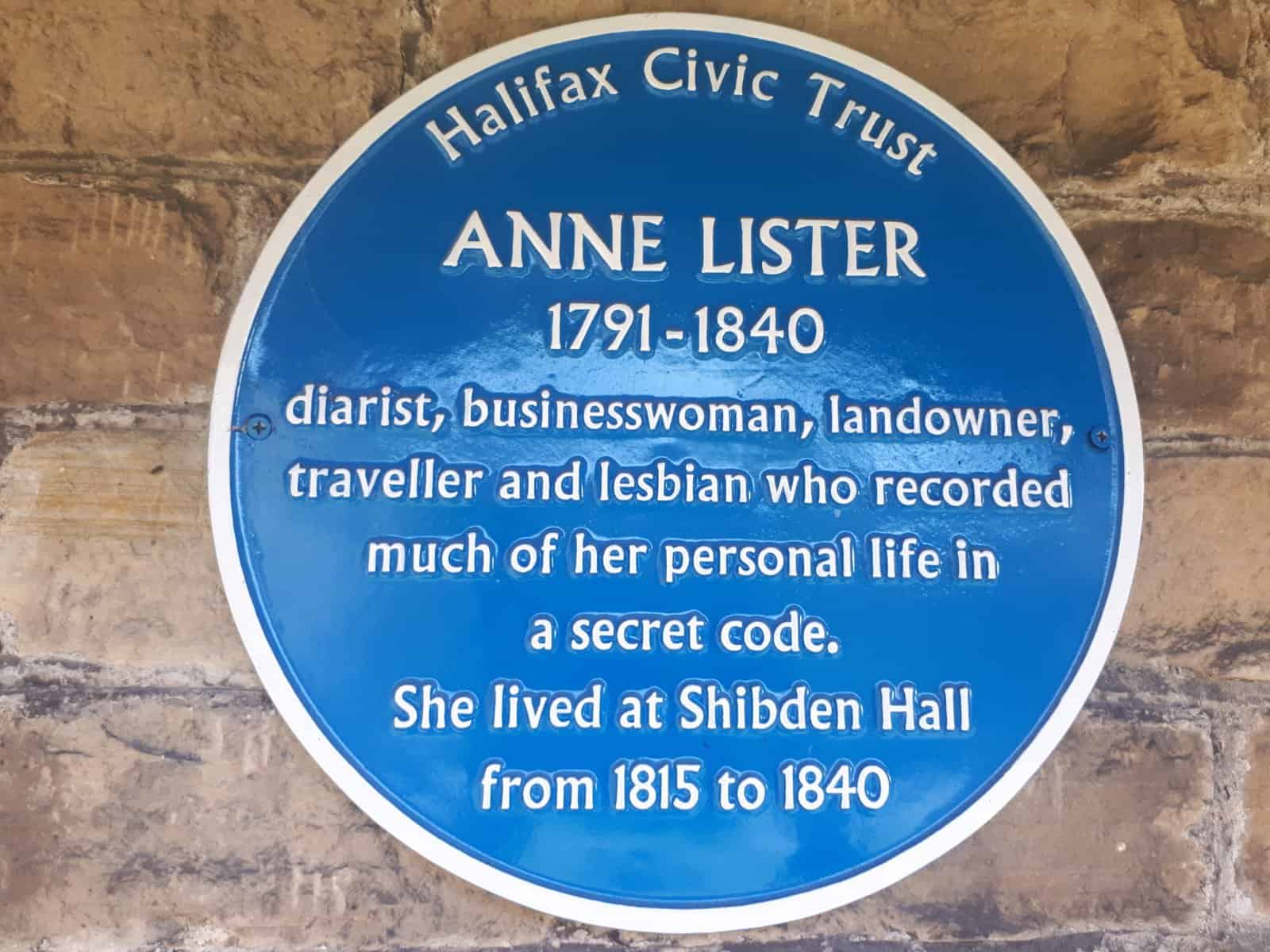Shibden Hall Museum and 1600s Aisled Barn are attractions included in the entrance fee for Shibden Hall and are only accessed from inside Shibden Hall, using the corridor near the buttery room that leads to the courtyard.
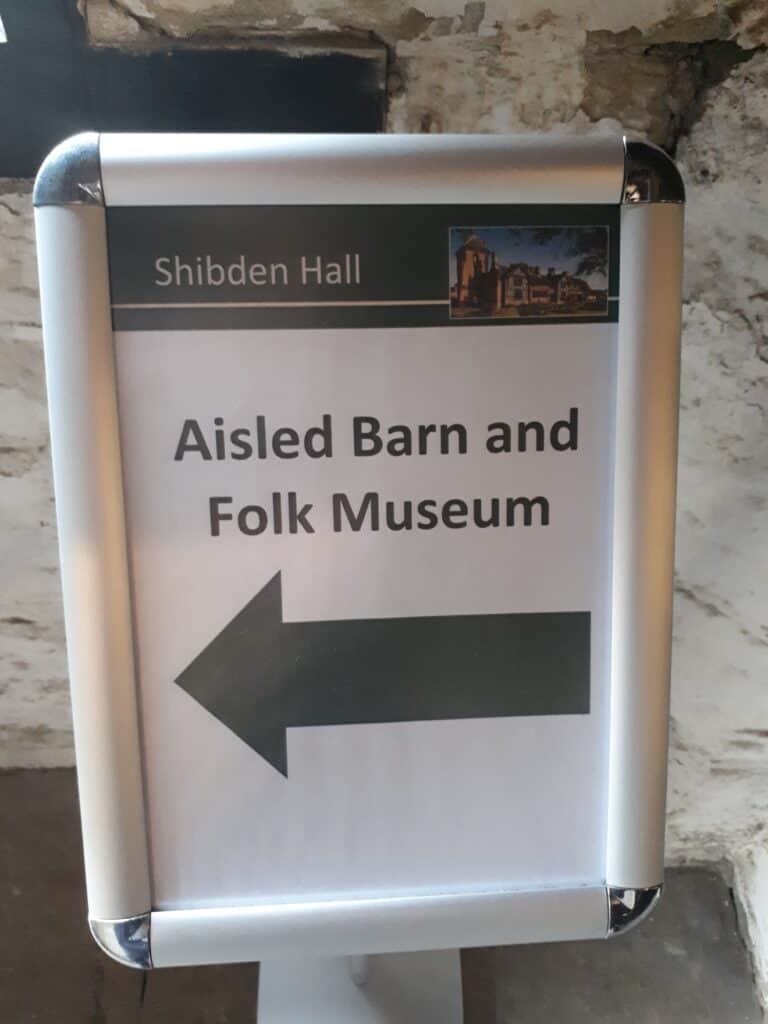
Access to the Shibden Hall Folk Museum and 1600s Aisled Barn is included with Shibden Hall Entrance Fee…
The folk museum was created in the 1950s to display a range of craft workshops reflecting the traditional way of life experienced by people living in the West Yorkshire Pennine area.
Contents
Shibden Hall Musem satnav/postcode
Use the Shibden Hall Top Car Park, Shibden Hall Road, HX3 7XA – located in the grounds of Shibden Hall for the nearest access to Shibden Hall’s entrance and the linked Shibden Hall Museum.
Pay and display charging times are 9am to 6pm in summer and 9am to 5pm in winter. 50p for up to 1 hour, £1 for 2 hours and £1.50 for over 2 hours. The machines take coins, and also APOCA cashless payment for iphone and android is available. There are 27 car parking spaces at this upper car park.
There is also a free 30-metre long parking layby, 200 metres up the road – in the town centre direction.
Alternatively, use the Shibden Mereside Car Park which is located off the A58 Leeds Road (Godley Lane), sat-nav Red Beck Road HX3 6XL.
However, Mereside Car Park is most convenient for the Shibden Park Boating Lake and Shibden Mereside Cafe and the Shibden Park Miniature Railway. Shibden Park Mereside Car Park is also known as the Bottom Car Park – you walk then through the magnificent Shibden Park to Shibden Hall which is clearly visble and sign posted.
Shibden Hall Museum – The Aisled Barn
The Aisled Barn at Shibden Hall is over 300 years old and was first recorded in 1677. It is constructed with a timber frame, dry stone walls and a Yorkshire slate roof. Those who watch the BBC/HBO series Gentleman Jack may recognise scenes using the aisled barn and courtyard, in addition to those shot in the interior of Shibden Hall.
Due to the historic nature of the buildings, Shibden Hall also featured in the 2018 film Peterloo, about the brutal dispersal by the cavalry of a radical meeting held on St. Peter’s Fields in Manchester on August 16, 1819.
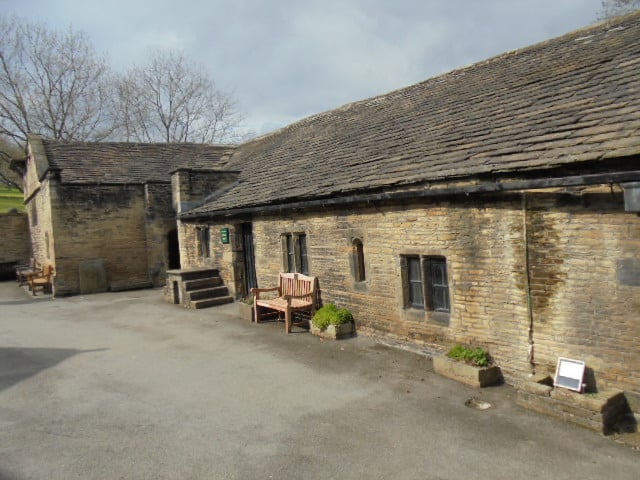
The cobbled floor has evidence of where the animal stalls were and the animal’s hay would be stored at the far side of the barn, up the steps.
Down a step in the corner of the Aisled Barn is the harness room for storing cleaning and mending saddles tack and carriage equipment.
From the 1950s the barn was used to house a number of historic carriages. Today there are five carriages on display including the Lister Chase the oldest surviving carriage in the world.
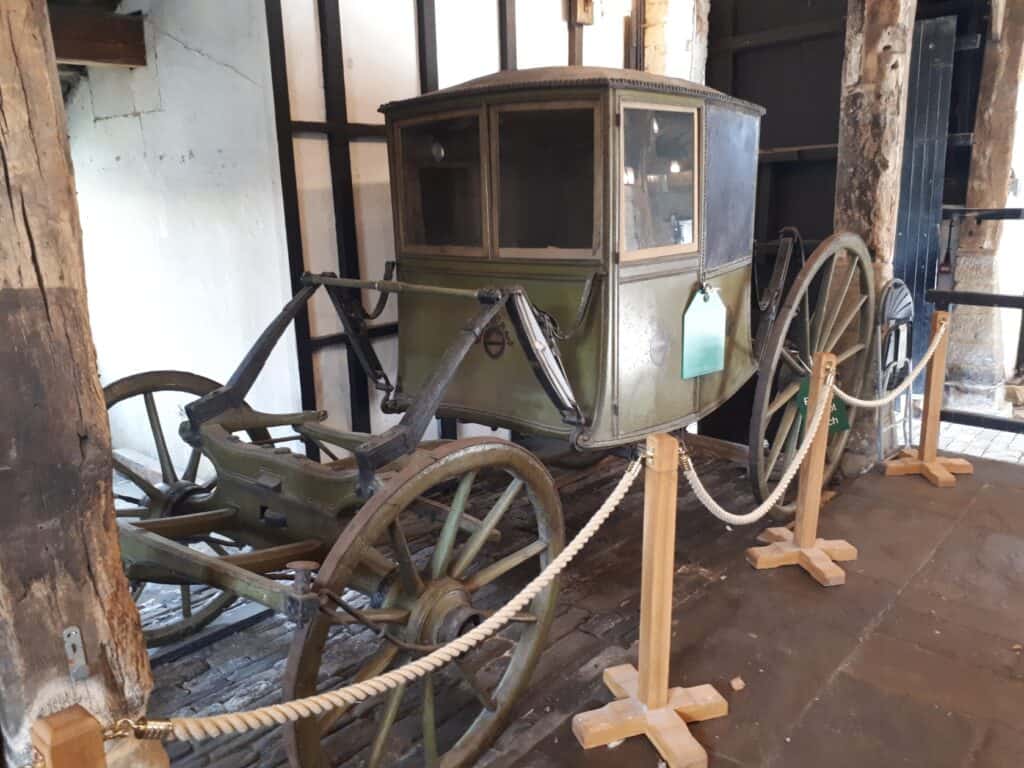
Built around 1725, the Lister Chase carriage is one of the oldest surviving carriages in the world. It was used by the Lister family at Shibden Hall for many years and has the Lister of Coat of Arms painted on each door.
The green and gold appear to be the original colours, although at some point it was painted grey before being restored and returned to the original colours in the 1950s.
The Lister Carriage was drawn by 2 horses, driven by a rider called a ‘position’ who rode on one of the horses.
Shibden Hall Museum – The Dairy
Milk from local cowherds was churned by hand to make butter using this Yorkshire built machine
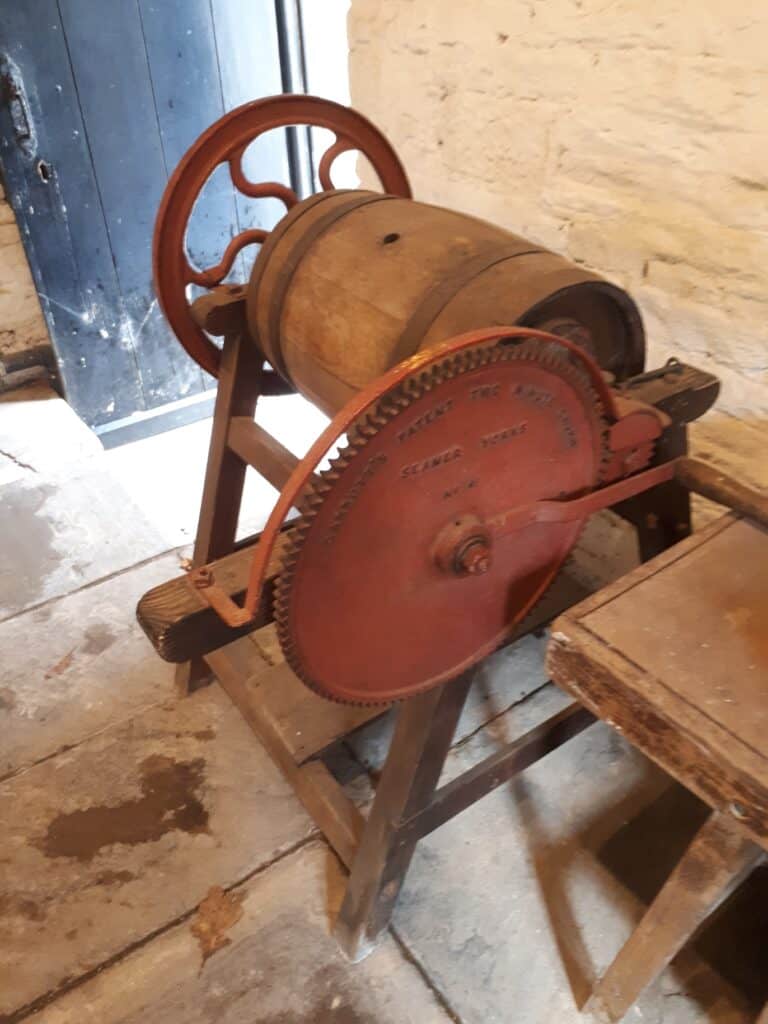
Shibden Hall Museum – Threshing Room
In the early 1800s century box threshing machine was used for separating the components of wheat and barley was driven by a gin and turned by a horse.
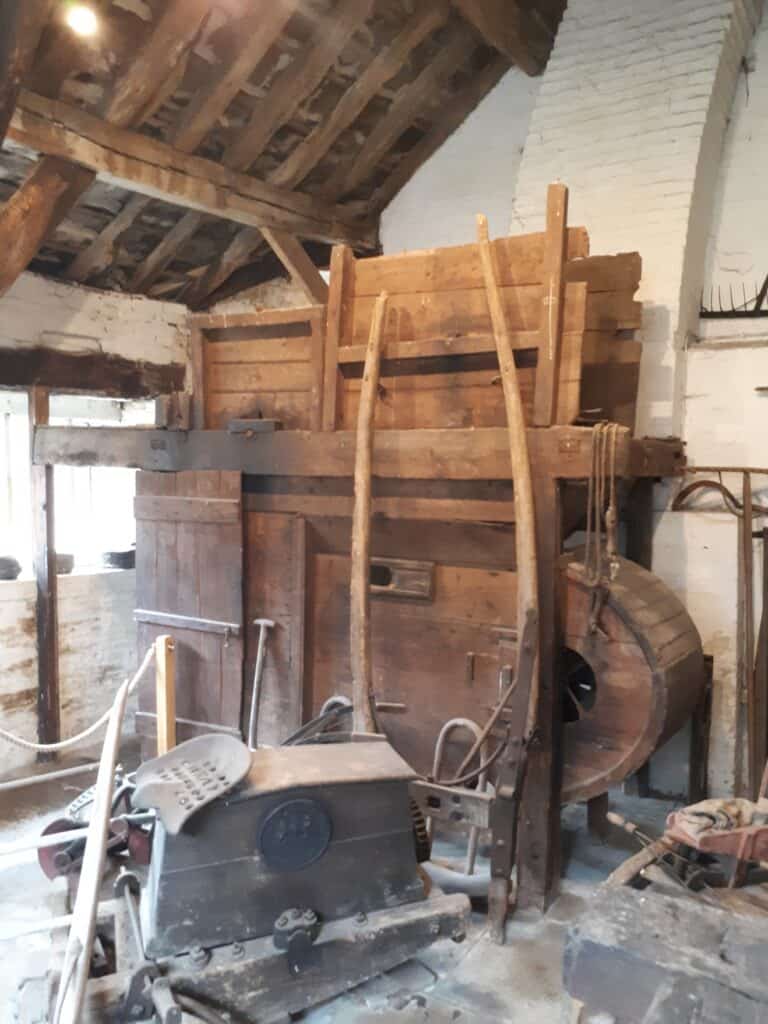
Shibden Hall Museum – Tack room
Saddles, harnesses and other such tack for the horses were stored in Shibden Hall’s Tack Room. Here we can take the opportunity to imagine equestrian life in Anne Lister’s era.
Prior to her permanent time living at Shibden Hall, in 1810, when Anne Lister was nineteen years old, her father, Captain Jeremy Lister gave her a horse. On the 30th August 1810 that same year, she writes in her diary about it to her current lesbian lover, Isabella Norcliffe
My father has got me a very spirited horse which is ready for me at any time in a quarter of an hour. It is exactly what I wished for, though I confess it is at present quite as much as I can manage. The moment one mounts it begins prancing and capering..
Whilst resident at Shibden Hall in 1822 still upset by what Anne Lister saw as the betrayal by her then lover, Mariana Belcombe, who married Charles Lawton, a wealthy landowner, Anne found tending to the horses a comfort.
However, on 22nd January 1822, it became necessary to have the Listers’ old mare put down as described in Anne lister’s diary…
One of the Mr Taylors (the young man) came at 7 this morning to destroy the old mare, Diamond. He stabbed her through the heart and she was dead in less than 5 minutes.
In 1822, the Lister family acquired three horses all of which were named by Anne Lister who was living at Shibden Hall with her aunt and uncle, at the time before she inherited the estate.
Anne was of high intellect so naming the horses was given much consideration. The names had to have meaningful associations with either literature, history or people.
Anne Lister’s horse called Vienne
From her diary, this horse was named Vienne with reference to Vienne, from a little circumstance relative to Vienne in Dauphiny – this was because was Vienne the birthplace of her married lover, Mariana Lawton (maiden name Mariana Belcombe) who was born in Vienne in 1790 during the time her father, Dr Belcombe, spent working on the Continent.
Ann Lister’s horse called Percy
One more this horse was named with reference to her married lover, Mariana Lawton whose full name was Mariana Percy Lawton. However, her choice of Percy as a name carried a double meaning for the third horse to be added to the Lister stable called Hotspur – Hotspur, who was known as Harry Hotspur – he was the son of Henry Percy, 1st Earl of Northumberland.
Ann Lister’s favourite horse called Hotspur
Most of Anne Lister’s contemporaries, were told she had named the horse Hotspur after Henry Percy (1364-1403) who was known as “Harry Hotspur”, a great northern warrior immortalised in Shakespeare’s play Henry IV but they did not know of the double meaning, that it relates to Percy – her lover with the Christian names of Mariana Percy.
Of the three, Hotspur was to be Anne’s exclusive property and from her diary…He is indeed a beautiful animal and is to be mine. I shall pay for him myself with the legacy my Aunt Lister left me.
The attention Anne lavished on her horses did much to alleviate the pain and sadness caused by Mariana’s marriage.
Shibden Hall Museum – Estate Worker’s Cottage
This room was created to display the typical living arrangements of rural workers in the 1800s. Entire families would live in cottages like this. The working day would last from sunrise to sunset, with children working alongside their relatives from a young age.
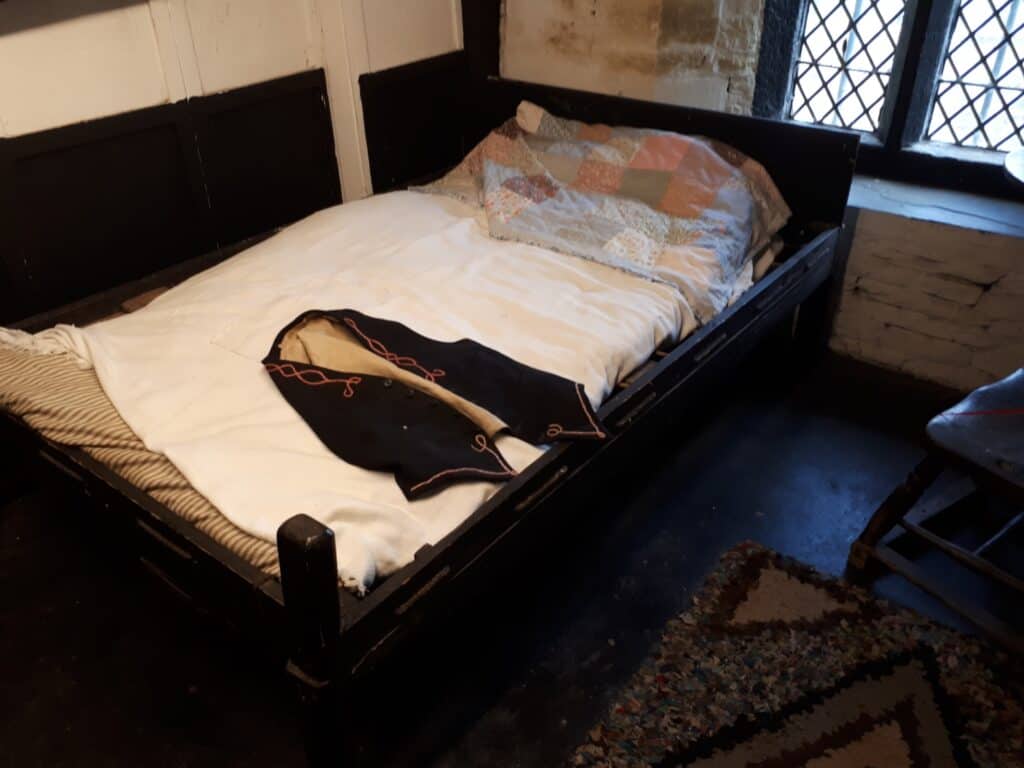
Shibden Hall Museum – The Luddites’ Crispin Inn
The interior features of this room came from the Crispin Inn, which formerly stood near Halifax Minster. The pub closed on 6th May 1959 and the historic interior and fittings with Luddite connections were moved to Shibden Hall.
The name Crispin belonged to an early Christian martyr whose fame spread throughout England after the Battle of Agincourt on 25 October 1415 only 5 years before the first record of a building on site at Shibden. The feast day is perhaps best known to some with reference to the St Crispin’s Day Speech in Shakespeare’s play Henry V.
Some of the glassware is inscribed Crispin Inn Halifax and the mahogany counter and china pumps are from the 19th century in pubs and inns in the 19th century.
Crispin Inn at Shibden Hall and Knurr and Spel Game
Gambling particularly on games involving knurr and spel were common. The spel is a flathead stick and the knurr is was a small wooden ball which thrown into the air by a specially made springtrap. The object of the game is ht the knurr as far as possible. An example of the equipment can be seen at the Bankfield Museum in Halifax.
As the exhibit above the fireplace shows, cockfighting was also prevalent and large sums of money changed hands. It is recorded that in 1680 the son of the landlady at the Union Cross Inn Halifax was so angered by the customers frequently fighting over the results he drew his rapier and threatened to stab the next person who threw a punch.
Crispin Inn at Shibden Hall, the Luddites and deportation to Australia
The Crispin Inn was used as a meeting place for the Luddites in 1812 who feared industrialisation would destroy their livelihoods is period. The Luddites faced legal and military force as they attacked mills, hoping to smash the new cropping frames which replaced skilled workers.
Although the Luddite Rebellion very quickly prompted the passing of the Frame-Breaking Act, which made the breaking of machinery a hangable offence. However, no one was sentenced to death under this Act of Parliament. Instead, prosecutors preferred to use existing legislation, trying Luddites for assault, destruction of property, or when those were not possible, using more creative means. The Luddites were named after King Ludd, the nickname they used for a large hammer used to break the machinery.
John Baines of Halifax and his son John (John Baines junior) along with three of his friends, were charged in January 1813 with administering an illegal oath at the Crispin Inn – the Luddite Oath, one sworn by members of the group on joining, a process they called “twisting in”. They would lay their hand on a “small book” (presumably a bible) and say:
“I, [name] of my own free will and accord do hereby promise and swear that I will never reveal any of the names of any one of this secret Committee, under the penalty of being sent out of this world by the first Brother that may meet me. I furthermore do swear, that I will pursue with an unceasing vengeance any Traitors or Traitor, should there any arise, should he fly to the verge of —- I furthermore do swear that I will be sober and faithful, in all my dealings with all my Brothers, and if ever I decline them, my name to be blotted out from the list of Society and never to be remembered, but with contempt and abhorrence, so help me God to keep this our Oath inviolate.”
Unfortunately for the men, one of those present at the Crispin Inn, John McDonald, was an informer for the government and his testimony saw them sentenced to transportation to Australia. John Baines senior, already an old man, died there two years later on board a prison ship. The other men were pardoned in 1816, but whether they made it home to Halifax, is not yet known.
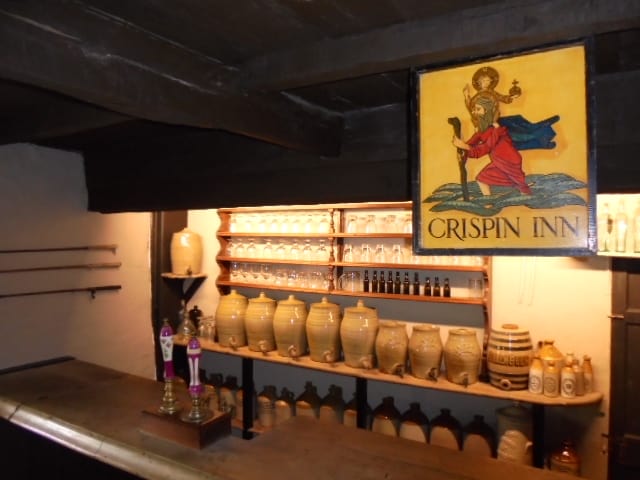
Shibden Hall Museum – Saddlers
The saddlers of Anne Lister’s era were skilled people working with leather, wood and straw using a variety of small intricate tools to make essensial items including saddles for riding and the back pads and collar harnesses for horses to pull carts, carriages and ploughs.
Their saddles and back pads were made with a wooden frame padded with straw and then covered in leather. The weather was held in with a clamped between the knees leaving the hands free to cut and stitch the parts together all three were stuffed very tightly with straw and further padded by flannel so the horse could not be changed whilst working.
Heavy-handed horse collars and black pads were called black goods whilst fine saddles were made of brown leather, usually pig skin rubbed with vegetable oil and were then ornamented with horse brasses. Many current-day country British pubs have historic horse brasses as interior design features.

Shibden Hall Museum – Brew House
Shibden Hall is recorded as having its own brew house in 1677. However the brew house at Shibden Hall now today was recreated from the Old White Beare Inn at Norwood Green (Old White Beare Inn 3 Village St, Norwood Green, Halifax HX3 8QG, 3 miles by road from Shibden Hall).
Dating from 1533, the Old White Beare pub and restaurant is named after one of the ships that beat the Spanish Armada in 1588 and some of the timbers were once part of that ship.
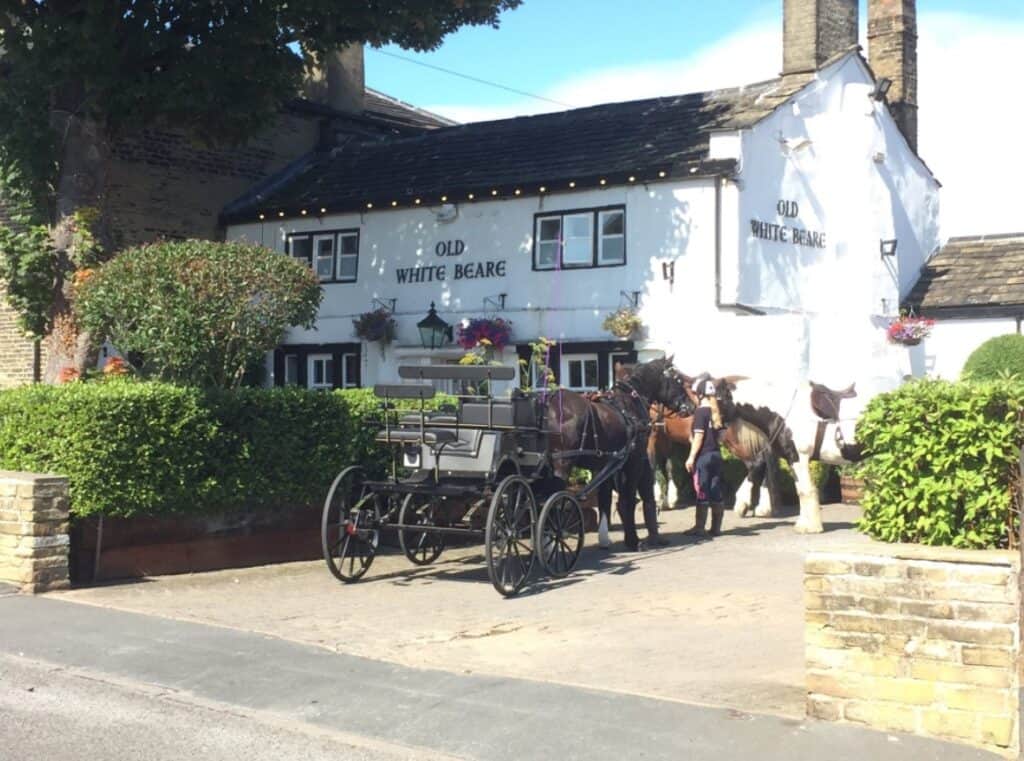
Shibden Hall Museum – The Apothecary
These days you would call an apothecary a pharmacy (but the general public tend to say a “Chemists” in modern Britain)
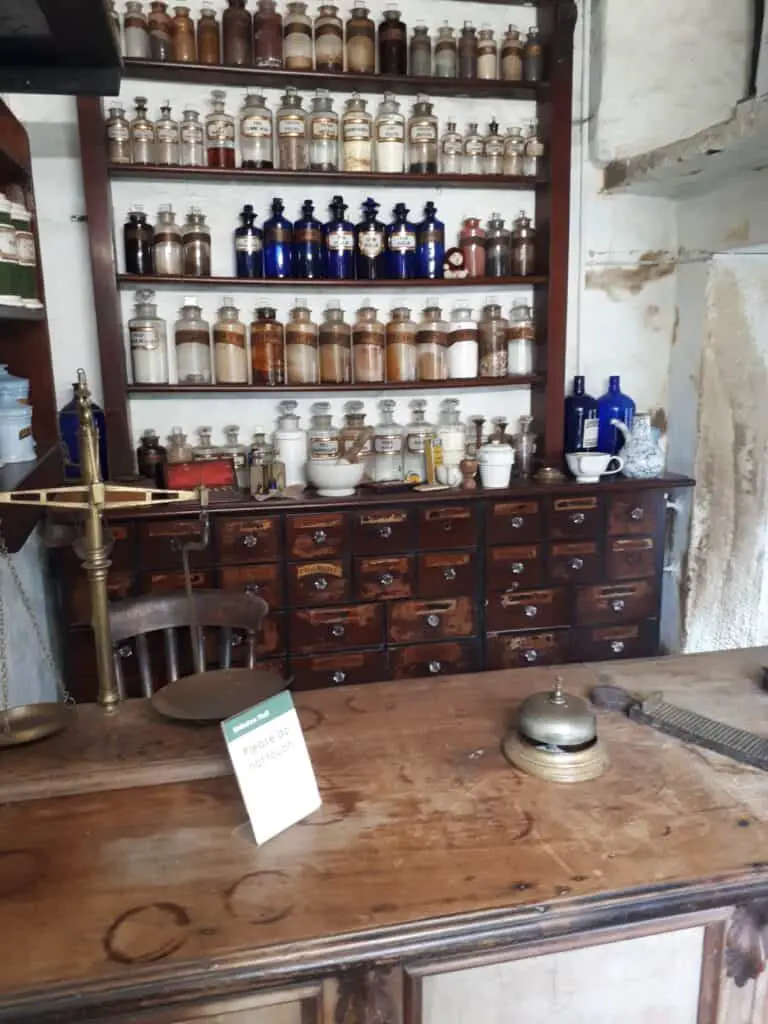
Shibden Hall Museum – The Blacksmiths
The term blacksmith comes from the metal iron, traditionally called “black metal” and farrier from the Latin ferrum, “iron” as blacksmiths made and fitted horseshoes.
The blacksmith played an important part in estate life – making and repairing agricultural equipment, iron tyres for cartwheels, hoops for use by the cooper to make barrels and metal work for tools, locks, keys, hinges and barriers.
The equipment used by blacksmiths – bellows, forge and anvil – has changed little over the centuries.
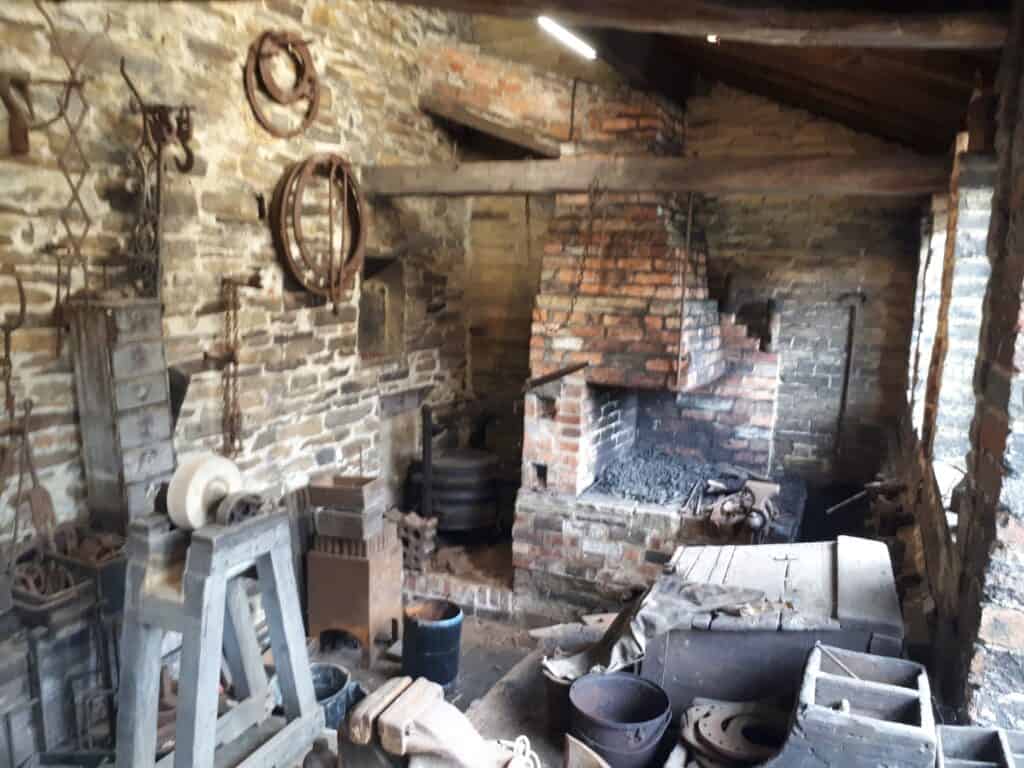
Shibden Hall Museum – Wheelwrights
Wheelwrights were high skilled craftspeople and processed detailed knowledge of the properties of timber and iron. Their working tools included hand-turned lathes, chisels and calipers.
The central hub of the wheel was usually made from elm, a hardwood that does not split. The spokes were made from billets of oak, split out of freshly felled trunks and stacked to season for 4 years.
The spokes were then driven into place in the nave of the wheel with a 14-pound hammer. The nave is the block in the center of a wheel, from which spokes radiate, and through which the axle passes.
The finished wheel had to be slightly saucer-shaped for strength. The felloes, curved sections of ash, were used to form the wheel rim. They were sawn from fresh green timber and left for a few years to season and then they were then trimmed to size with an adze and plane and had holes bored in them to receive the spokes.
The metal tyre is measured and bent into a circle and the joint is welded together and a number of holes punched through it to take nails. The tyre is heated and levered in position around the wooden wheel and then quenched with water to shrink the iron tyre permanently onto the wheel.
The wheel would receive several coats of lead paint and perhaps have some ornamental lines painted on it before the wheel was finished.
A cast-iron cylinder or box had to be fitted to take an axle so the finished wheel could be fitted on a wagon, carriage or cart.
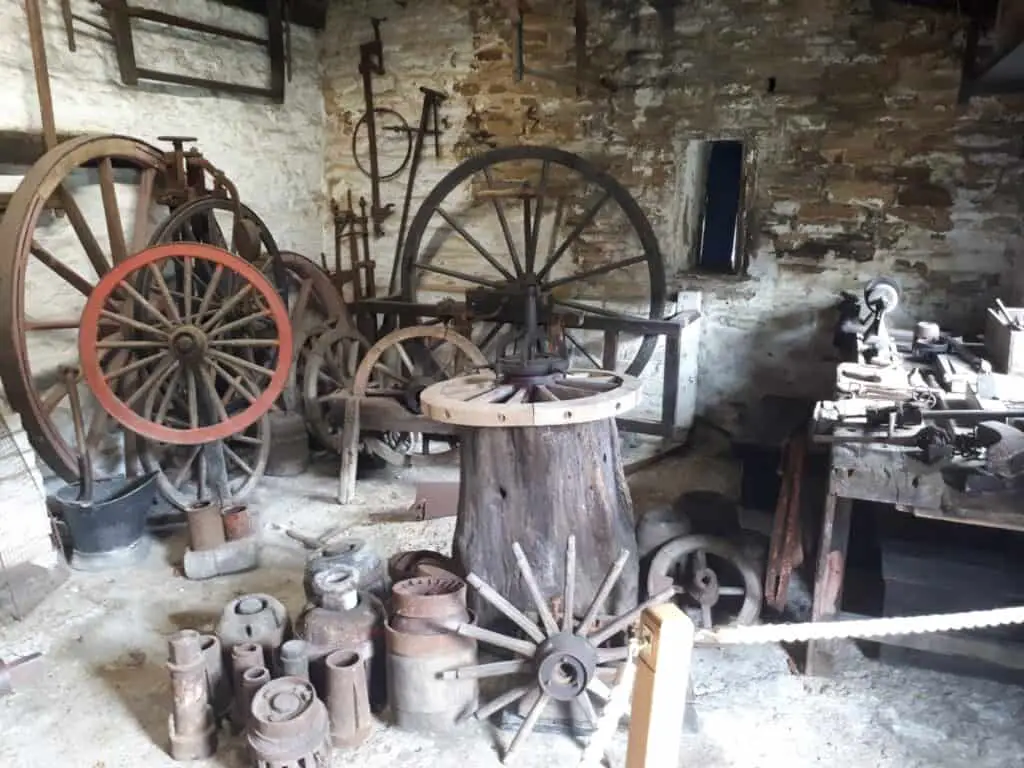
Shibden Hall Museum – Coopers
A cooper is a barrel maker and craft of coopering dates back more than 4,000 years to ancient Egypt. The word ‘‘cooper’’ is derived from the Latin ‘‘cupa’’, meaning barrel.
After a 7 year of apprenticeship, a cooper in the 1800s could make 3 barrels a day. The barrels were made to last and could be in use for 50 years.
The cooper’s trade was very specialised – they not only made casks and barrels to hold wet and dry goods but also other domestic items such as butter churns, laundry tubs and bathtubs.
Coopers tended to use their knowledge and experience to make barrels by eye and feel, rather than measuring them using a range of tools such as planes, chisels, croozes and jiggers.
The hoops to hold the wooden struts together were heated and forged over fires.
In the 1800s, Halifax had 6 coopers. The number of people who used to make and repair casks in Britain is reflected by the large number of people with the surname Cooper.
There are now only a handful of coopers left in England although there are over 300 in Scotland, including apprentices, where the cooper craft maintains strong links with whisky distilleries and their strong demand.
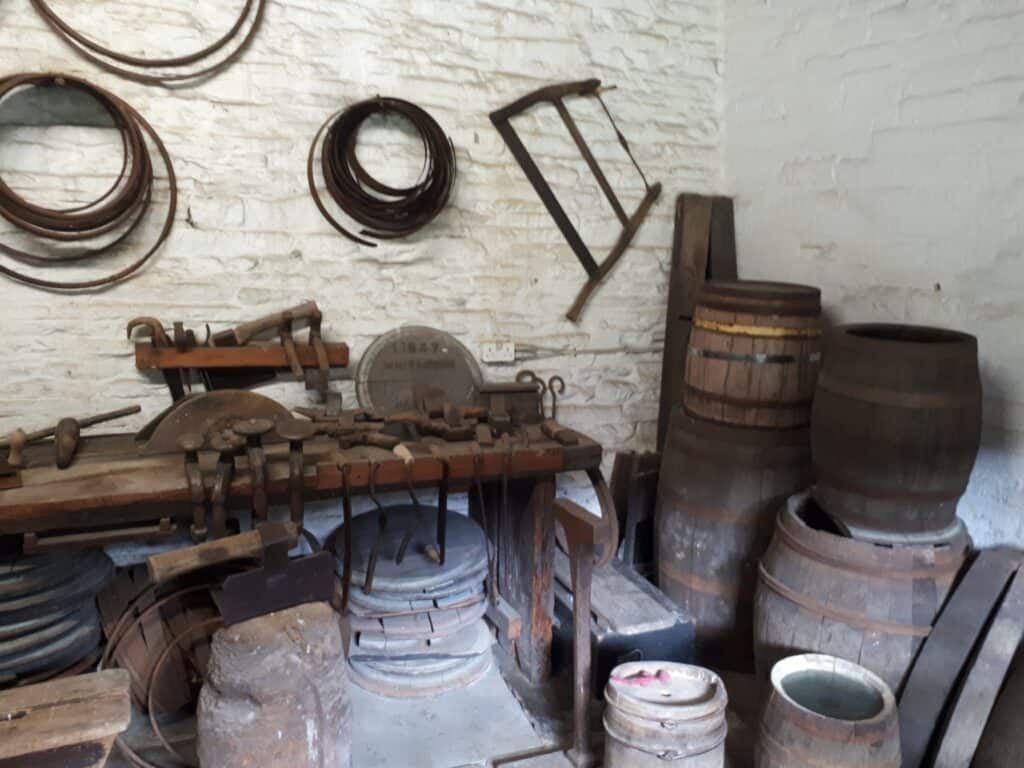
After a 7 year apprenticeship, a cooper in the 1800s could make 3 barrels a day
Shibden Hall Museum – Basket Weaving
In the Calder Valley, basket making was established on the River Calder near Elland – about 4 miles from Shibden Hall, where a specific type of willow ideal for basket weaving was grown – Salix Viminalis.
Shibden Hall Museum Wheel Chair Accessibility
The Shibden Hall Folk Museum is not wheelchair accessible. The historic Ailsed barn is accessible to a degree, but please be aware there are uneven cobbles on the floor. An accessible toilet is to the right of the disabled parking area. For access advice or assistance, please contact Shibden Hall prior to your visit, staff will be happy to help.
See here for our post on Shibden Hall and a room-by-room guide of Anne Lister’s home and for things to do in Halifax, with or without children, click here.

